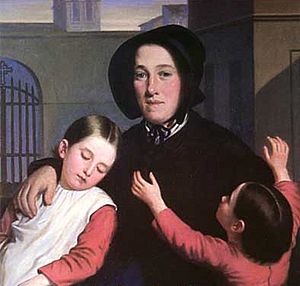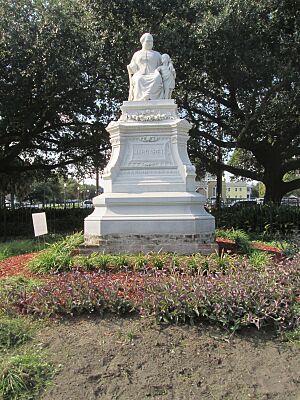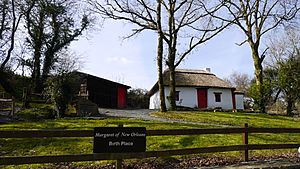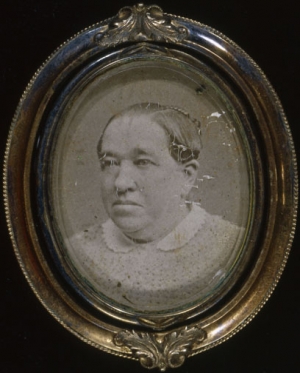Margaret Haughery facts for kids
Margaret Haughery (1813–1882) was a kind woman known as "the mother of the orphans." People in New Orleans, Louisiana, in the 1880s loved her very much. They called her "Our Margaret," "The Bread Woman of New Orleans," and "Mother of Orphans." Margaret spent her life helping the poor and hungry. She also worked to fund and build orphanages across the city.
Margaret was an Irish immigrant and a widow. She had many nicknames like "Angel of the Delta" and "Mother Margaret." She was a Catholic and worked closely with the New Orleans Sisters of Charity. These sisters were part of the Roman Catholic Archdiocese of New Orleans.
She helped open four orphanages in the New Orleans area in the 1800s. Many years later, some of these places became homes for the elderly. Margaret was famous for always helping those in need. Some people even thought she was a living saint. She was born poor and became an orphan herself when she was young. She started her adult life doing laundry and selling things. But she died a successful businesswoman and helper of others. She even had a state funeral.
Contents
- Margaret's Early Life
- Moving to America
- Marriage and New Beginnings in New Orleans
- A Successful Businesswoman
- Helping During the Civil War
- Margaret's Life in New Orleans
- Orphanages Margaret Helped Build
- Margaret's Simple Dress
- Illness and Death
- A Special State Funeral
- The Margaret Statue
- New Interest in Margaret
- More About Margaret
Margaret's Early Life
Margaret was born in a stone cottage in Ireland in 1813. She was the fifth child of William and Margaret O'Rourke Gaffney. Her parents were from Tully South, in Carrigallen, County Leitrim. Her father had a small farm and might have been a tailor.
In Ireland, the years 1816 to 1818 were very hard. There were bad harvests and cold winters. Because of this, many people left Ireland. In 1818, Margaret's parents, William and Margaret, left for the United States. They took Margaret, who was five, her older brother Kevin, and baby sister Kathleen. Three older children stayed behind with their uncle. It was a sad goodbye for the family.
Moving to America
The journey across the ocean by ship took six months to reach America. Strong storms made the trip very slow. People on the ship worried they would never reach land. Food became very scarce. Margaret's father even used the lid of their destroyed trunk to rock his young children. The ship finally reached Baltimore. During the long trip, a Welsh woman named Mrs. Richards became friends with the Gaffney family.
Soon after they arrived in Baltimore, Maryland, baby Kathleen died. Margaret's father, William, was not used to city life. It was hard for him to find work. He got a job moving goods at the Baltimore docks. He sent money to Ireland for his children who stayed behind. But in 1822, a yellow fever sickness spread through Baltimore. Margaret's parents, William and Margaret, died within days of each other. They were buried in St. Patrick's cemetery. Most of their belongings were burned to stop the sickness from spreading.
Margaret was nine years old and had no home. Her older brother Kevin disappeared and was never seen again. Mrs. Richards, who had traveled with Margaret's family, heard about her situation. Mrs. Richards had also lost her husband to yellow fever. She took Margaret into her home. Margaret lived there for some years and worked for her keep. She never went to school and never learned to read or write. When she was old enough, Margaret started working in other people's homes. This was common for Irish women in Baltimore at that time.
Marriage and New Beginnings in New Orleans
On October 10, 1835, when she was 21, Margaret married Charles Haughery in Baltimore. He was also from Ireland. Margaret convinced him to move south for his health. They left Baltimore on a ship and arrived in New Orleans on November 20, 1835. Like many people in New Orleans, they faced sicknesses like yellow fever and cholera. Charles's health got a little better, but it did not last. Doctors suggested a sea journey for him.
Charles decided to go to Ireland. His trip was delayed until after their first child, a girl named Frances, was born. Charles eventually made the trip. But after some months, Margaret learned he had died soon after reaching Ireland. A few months later, baby Frances became very sick and died. This was the second time Margaret had lost her entire family. She was only 23 years old. She said, "My God! You have broken every tie: You have stripped me of all. Again I am all alone.”
Even after these sad events, Margaret was determined to help widows and orphans. She understood their struggles very well. The Sisters of Charity ran the Poydras Orphan Asylum. Margaret gave any extra money from her laundry work to the orphans. She later left her hotel job to manage the orphan asylum for the sisters. When the orphans needed food, she bought it for them with her own money. Margaret's hard work helped pay for the Female Orphan Asylum of the Sisters of Charity, built in 1840.
A Successful Businesswoman
During a yellow fever sickness in New Orleans in the 1850s, Margaret went from house to house. She helped sick people and comforted dying mothers. She promised to look after their children. She also helped open the St. Theresa's Orphan Asylum. Margaret worked with Sister Regis to build St. Theresa's Church too.
Margaret saved money from her wages and bought two cows. She used them to provide milk for the children. She bought a small cart and sold extra fresh milk in the Vieux Carré (French Quarter). Soon, she started a dairy with nineteen cows. The dairy grew and became very successful. Margaret bought more cows and started selling cream and butter. Within two years, she had forty cows and a good business. People knew her as a businesswoman who sold her products from her handcart. She also supported the St Vincent de Paul Infant Asylum, which opened in 1862.
Even though Margaret gave a lot to charity, her money kept growing. She was a hard-working woman who wanted to feed the orphans. At one point, Margaret worked at a bakery. She later loaned money to a baker. But she soon found out his business was about to fail. She had become the main owner of the business. Margaret realized the only way to get her money back was to take over and run the bakery.
The bakery became known simply as Margaret's Bakery. It quickly became a big success. This is where she made most of her money. For years, she continued her rounds with a bread cart, which replaced her milk cart. Margaret sold bread locally and also sent it to other places. All the orphanages in New Orleans received bread from her bakery for almost no cost. She always worked to improve the bakery. It became the first steam bakery in the South. It also gave jobs to many people. The bakery was so successful that it was not affected by the Civil War.
Margaret's successful bakery became very famous. Margaret Haughery & Company was the first steam bakery in the South. The bakery sold "Margaret's Bread," and she became known as the "Bread Woman of New Orleans." She later owned a popular store called the Klotz Cracker Factory.
People who were struggling and homeless would gather on Levée Street. Margaret would always give them half a loaf of bread. She cut it in half so they could not sell it to buy alcohol.
Helping During the Civil War
The Civil War greatly affected New Orleans. It caused many more people to become orphans or need help. Margaret worked to ease the suffering. She helped those who had trouble getting food during the war. She gave wagonloads of bread and flour from her bakery to the hungry people of New Orleans.
In 1862, the Union Army took control of New Orleans. Union General Benjamin Franklin Butler set up rules like barriers and curfews. No one was allowed to cross these barriers or be outside after a certain time. Margaret kept giving food and milk to people beyond the barriers. General Butler warned her to stay behind the lines. He said she would be shot if she crossed them again. She asked him if President Abraham Lincoln wanted the poor to starve. General Butler replied, "You are not to go through the picket lines without my permission, is that clear?" Margaret answered, "Quite clear." Butler then said, "You have my permission."
After the war, during the Reconstruction period, Margaret supported efforts to keep peace in Louisiana. She even gave a special sword to a US General. This sword is now in the Louisiana State Museum.
Margaret's Life in New Orleans
After the Civil War, Margaret earned enough money to build a large steam factory for her bread. By this time, everyone in the city knew her. Children loved her, and business people were proud of her. Poor people came to her for advice. She would sit at the open door of her office in a simple dress. She always had a kind word for everyone, rich or poor. Important women, bankers, and merchants sought Margaret's advice.
Sitting in her bakery doorway, she became a big part of the city's life. People from all walks of life asked her for advice on their businesses. Her wisdom was well-known. The people of New Orleans called her "Our Margaret." They said she had great energy and courage, but also very gentle and kind manners.
When Margaret first arrived in New Orleans, many Irish immigrants came looking for work. The city was known for both sickness and opportunity. Irish men often took dangerous jobs that others avoided, like digging canals or building levees. During the building of the city's New Basin Canal, many workers died. This left many widows and orphans. The Irish often lived in poor areas and were easily affected by sicknesses. By 1860, 14% of New Orleans' population was Irish.
During Margaret's life in New Orleans, yellow fever was a constant danger. In one three-year period, it killed 13,000 people. Margaret also survived a big hurricane in 1856 and a flood in 1849. The flood left 12,000 people without homes.
Orphanages Margaret Helped Build
Margaret, the "Mother of Orphans," helped build several orphanages in New Orleans. These included St. Elizabeth Orphan Asylum, the Louise Home for girls, and St. Vincent Infant Asylum. She also helped build an asylum and church that became St. Theresa of Avila Church. She gave money to Protestant and Jewish charities too. In her will, she left money to many different orphanages. These included homes for Protestant, German Protestant, German Catholic, and Jewish orphans. She also gave to the Daughters of Charity of St. Vincent de Paul and many others.
The Sisters of Charity moved to a new location in New Levée Street in 1836. It was an old, empty house. This was the first Catholic orphan asylum in New Orleans. Margaret wanted to help the sisters get started. But here, she found her true purpose. She showed great energy and business skills. She became the manager of the asylum. She proved the house could be lived in. But the landlord then put the building up for sale. So, within two years, they needed a new home again.
Margaret knew of a house on an empty plantation nearby. She convinced the owner to let them use it for free. She was happy to get the children out of the city and into the Louisiana countryside. The children were taught to read, write, and sew. They were prepared for life outside the orphanage.
Margaret's big dream was to provide a permanent home for the orphans. In 1840, work began on St. Theresa's Asylum. The land was given by F. Saulet. Margaret mostly paid for the project herself. Others also gave donations because she asked them to. It took ten years to pay off the debt. Margaret also continued to support the orphanage at the plantation during this time.
Around the mid-1800s, yellow fever spread widely again. The sickness made thousands of children homeless in 1853. Margaret visited the homes of sick people, no matter their background or religion. She helped them and promised dying mothers she would care for their children. She met so many orphans that she started a new project. She called it a "baby house." All her profits went into this new effort. It became the large St. Vincent Infant Asylum, which opened in 1862. It took sixteen years to pay off the debt, mostly paid by Margaret.
Other homes opened in the 1850s and 1860s. These included the Louise Home for working girls and the St. Elizabeth House of Industry. During the yellow fever outbreaks, she visited the sick and dying. She helped everyone, no matter their race or religion. She comforted mothers by promising to care for their children.
It is thought that Margaret gave about $600,000 to charity.
Margaret's Simple Dress
Even with all her money, Margaret spent little on herself. She was known for owning only two dresses. One was a plain dress for every day. For special events, she wore a plain silk dress and a shawl. She always wore a Quaker bonnet, which became her special look.
Illness and Death
At 69 years old, Margaret became sick with a disease that could not be cured. She was cared for by her friends, the Sisters of Charity, for many months. People from all walks of life visited her during her illness. Important people in New Orleans knelt by her side. Pope Pius IX sent his blessing and a cross.
Margaret died on February 9, 1882. Her body was taken to St. Vincent Infant Asylum. Her funeral was held on the following Saturday morning. Newspapers announced her death as a public sadness. The city newspapers had black borders to mark her passing. Her obituary was on the front page of The Times-Picayune newspaper.
A Special State Funeral
The funeral procession started at the asylum. It included 13 priests, led by Archbishop Napoléon-Joseph Perché. New Orleans Mayor Benjamin Flanders led the procession. Two Lieutenant Governors of Louisiana helped carry her coffin. Thousands of people attended her funeral. These included important politicians, business people, and religious leaders.
Orphans from all the city's asylums were there, both black and white. The historic Mississippi fire brigade, of which she was an honorary member, also attended. Nuns from many groups, along with close friends, were present. The streets, sidewalks, and windows were filled with mourners. Three generals, religious leaders of all faiths, and city officials were there. The procession passed the New Orleans Stock Exchange at noon. Members stopped their work and came outside. St. Patrick's Church (New Orleans, Louisiana) was so crowded that it was hard to get the coffin through the aisle.
A special church service was held. Her friend Father Hubert gave the sermon. Margaret was buried in the same Saint Louis Cemetery No. 2 tomb as her good friend Sister Francis Regis. Sister Regis was a Sister of Charity who died in 1862. Margaret had worked with her on all her early efforts to help the poor.
Margaret's will was read a few days later. In her will, she left everything to charities. She gave money to help widows, orphans, and the elderly, no matter their religion. She left all her wealth to charities, except for the bakery. She gave the bakery to her foster son, Bernard Klotz.
When Margaret died, people found that she had saved a lot of money, even with all her giving. She left every cent to the different orphanages in the city. Each one received something. It did not matter if the orphanages were for white or black children, or for Jews, Catholics, or Protestants. Margaret always said, "They are all orphans alike." Margaret signed her will with a cross instead of her name. This was a reminder that she never learned to read or write. It showed her humble beginnings, her great business success, and her impact on people.
The Margaret Statue
The people of New Orleans said, "She was a mother to the motherless; she was a friend to those who had no friends. She had wisdom greater than schools can teach. We will not let her memory go from us." So, the idea of building a public statue for Margaret came about naturally.
A committee was quickly formed to oversee the building of a statue in Margaret's honor. A place was bought between Camp, Prytania, and Clio streets. Alexander Doyle, a young sculptor, was hired. The statue was made from old photographs. It was first shaped in clay. This clay model was sent to Italy to be carved in marble. The first marble statue had some flaws, so the sculptor made another perfect one.
The statue was revealed on July 9, 1884, two years after her death. Children from every orphanage in the city were there. Former Governor Francis T. Nicholls gave a speech. The statue cost $6,000. This money was given in small amounts, like nickels and dimes. No large sums were accepted. The statue has only one word on it: Margaret. The statue shows her sitting in a low chair, like she did in her office, or when she drove her cart.
The small park where Margaret's statue stands is officially named Margaret Place. It has often been said that this is the first public monument built for a woman in the United States. The statue shows a woman sitting with her arms around a child. Margaret wears simple clothes and a bonnet. She looks kind, like a mother.
The small park is located where Camp and Prytania Streets meet in New Orleans. The beloved statue has a plaque with one word: "Margaret."
At the time, Margaret's statue was thought to be the first monument in the United States to honor a woman. A leading New Orleans newspaper said, “She was the most deserving, the most famous, of all the women of New Orleans, in our time or any other.”
Many still say Margaret's sculpture is the first American statue of a notable woman. Officially, it is the second US monument to honor a woman. A monument to Hannah Dustin in New Hampshire was built in 1879, five years before Margaret's. But Margaret's monument is the first public statue of a woman in the United States. It is also the first monument to an American woman who helped others, and the only known statue to a baker.
New Interest in Margaret
A group in Ireland called the "Margaret of New Orleans Tully Committee" is rebuilding Margaret's birthplace cottage. They are using original stone. The group wants to teach more people about Margaret and her life's work.
A documentary film about Margaret, called Who is Margaret Haughery? And why don't you know who she is?, is being made. It will include interviews with historians.
In 2009, a theater company in Ireland put on the first play about Margaret's life. The show had original music and songs.
The Ogden Museum of Southern Art now owns an original painting of Margaret by Jacques Amans.
More About Margaret
Margaret had three older siblings who stayed in Ireland when she and her parents moved to America. Margaret only saw one of them again, her older brother Thomas. He visited her in New Orleans in 1857.
Margaret was first buried with Sister Regis. Later, the Sisters of Charity moved their shared tomb to a new mausoleum vault in St. Louis Cemetery No. 3. Margaret, Sister Regis, and other Sisters of Charity are listed on plaques there. Margaret's final resting place is an unmarked vault.
In his speech at Margaret's funeral in 1882, Archbishop Perché said, "I have already been asked whether Margaret Haughery... was a saint. It is not for me to say. But, if you ask yourselves, dear friends, you may find an answer like a little boy once gave. A sister in Sunday school asked someone to define a saint. 'I think,' said the child, 'that a saint is one who lets the light shine through.'”






